Treasures of Khmer Culture-The National Museum of Cambodia
“Treasures of Khmer Culture-The National Museum of Cambodia” by Darryl Collins
(First published in 2005, this article reprint appears here with the author’s kind permission)
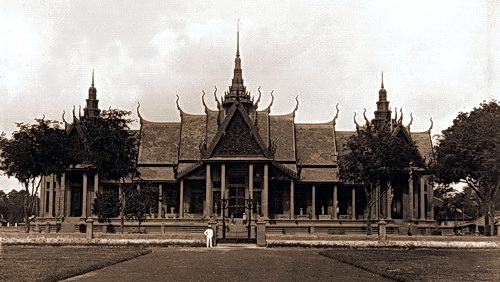
Phnom Penh, Cambodia – Visitors to Phnom Penh from the 1920s, as they still do to this day, identified the capital of Cambodia by the graceful silhouettes of the Royal Palace buildings and the imposing façade of the then Musée Albert Sarraut that is known today by its more familiar title, the National Museum of Cambodia.
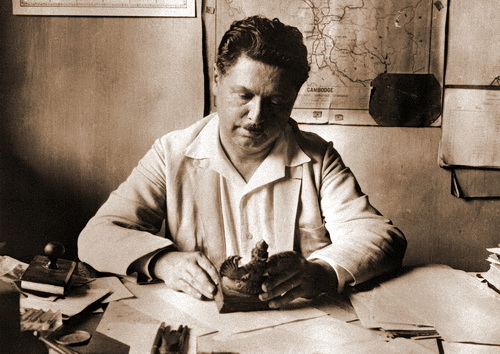
George Groslier (1887-1945), historian, curator and author was the motivating force behind much of the revival of interest in traditional Cambodian arts and crafts, and it was he who designed this quintessential building that is today synonymous with ‘traditional Khmer’ architecture. It is perhaps better described as a building enlarged from Cambodian temple prototypes seen on ancient bas-reliefs and reinterpreted through colonial eyes to meet museum-size requirements.
Groslier, the first baby born in Phnom Penh of French parentage, returned to Phnom Penh in 1909 after being sent to France in 1891 for schooling. The original concept behind the museum was that it be paired with a school teaching arts and crafts to Cambodian students so they could preserve the pure, untainted forms of traditional decorative and applied arts rather than ‘modern’ debased work. This reasoned Groslier, could best be accomplished by copying designs from original works of art on exhibition.
The museum building itself featured the work of many of these same young Khmer artisans who contributed their talents to the carving of the massive entrance doors and window shutters and decorated the interior panels with paintings featuring mythological subjects. These treasures are fortunately still in place.
Early beginnings
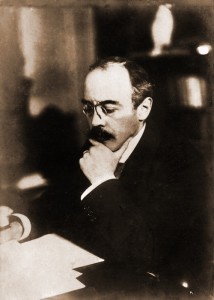
The earliest known collections that pre-date this spectacular crimson building are the Musée Khmèr that displayed only samples of Khmer archaeology in the confines of the Royal Palace (1905) and the Musée de Phnom-Penh of the same year that displayed examples of Khmer sculpture within the compound of the former Lycée Sisowath.
Conservateurs of these early collections between 1905 and 1919 were: L-A. Rousseau, L. Pétillot, Henri Marchal, Roland Meyer and J. de Villeneuve.
Groslier’s intended museum was soon associated with the Ecole des Arts cambodgiens (1917) and became known as the Musée du Cambodge in 1919. In 1920, this museum was soon to be officially renamed Musée Albert Sarraut after the then Governor-General of Indochina. The official portrait of M. Sarraut (above) was included in the 1920 publication, Cérémonie d’Inauguration du Musée Albert Sarraut et de L’Ecole des Arts cambodgiens.
Construction of the Musée Albert Sarraut
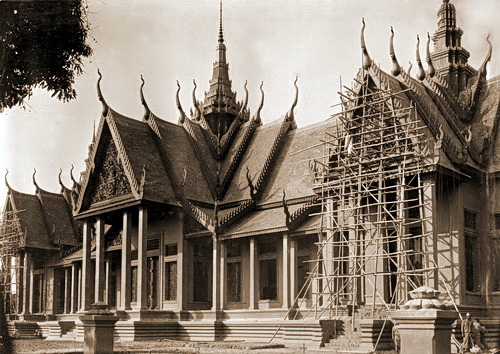
The foundation stone for the new museum was laid on 15 August 1917. Some two-and-a-half years later, the completed Musée Albert Sarraut was inaugurated during Khmer New Year on 13 April 1920 in the presence of H.M. King Sisowath, François-Marius Baudoin, Résident-supérieur, and M. George Groslier, directeur des Arts cambodgiens, and conservateur du Musée.
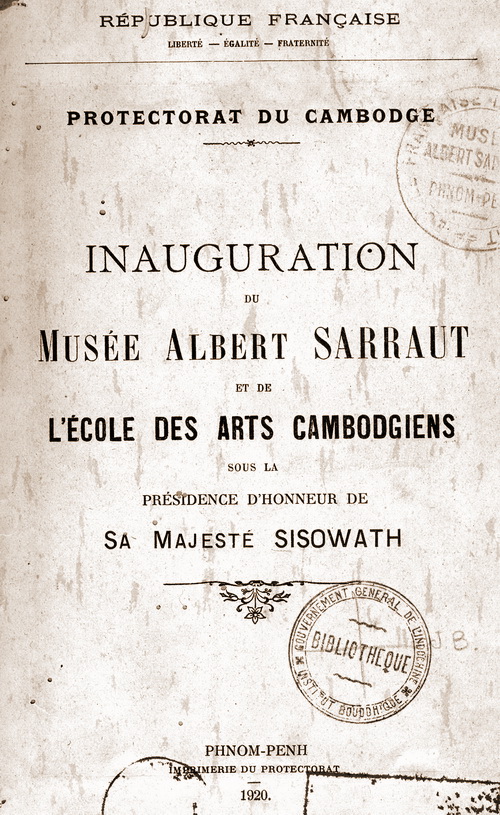
The original design of the building was slightly altered in 1924 with extensions that added wings at either end of the eastern façade that made the building even more imposing.
As can be seen from period photographs, the museum currently displays many items – in particular the bronze collection, in showcases that are part of the original furnishings.
The Collection
The collection is housed in high-ceilinged galleries open on one side to a square courtyard set with four pools and a manicured garden planted with palms. It is a haven amidst bustling Phnom Penh. The galleries are arranged systematically from the front of the building in a clockwise direction. As Khun Samen, the present Director has whimsically noted, the majestic statue of Garuda ‘king of the birds’ that faces visitors as they enter the building, shows you the direction to take by pointing to his right.
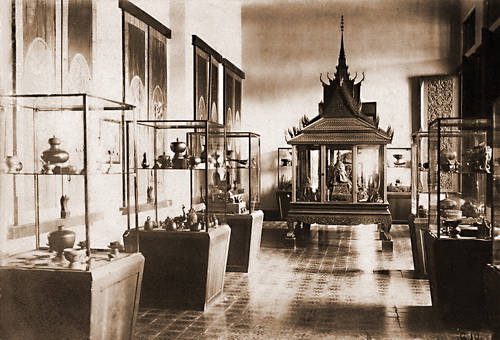
The four museum galleries are best understood by their orientation – in the east, the Bronze Galleries containing superb examples of Khmer bronze casting techniques from the 6th to 13th centuries. Further to the south of these galleries is a new display dedicated to prehistory finds of early ceramics, metal and stone. To the north of the Bronze Galleries, is a special exhibition space currently displaying fine and rarely- seen examples of Post-Angkorian Buddha images.
The remaining three main galleries surrounding the courtyard progress in an orderly fashion – the Southern Gallery displays sandstone sculptures from the 6th to 11th centuries (Phnom Da to Baphuon styles). The West Gallery exhibits works of art from the classic Angkor Wat and Bayon styles from the 12th to 13th centuries – it is here the statue of King Jayavarman VII is displayed; while the North Gallery is primarily dedicated to decorative and applied arts – woodcarving, lacquer, ceramics and metalwork.
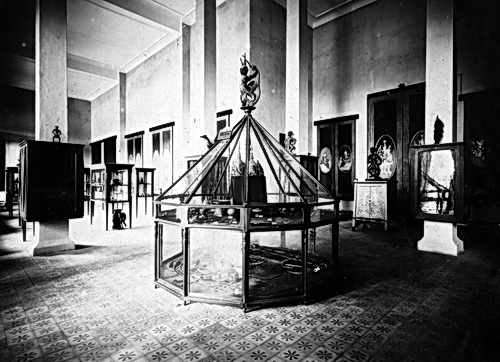
The porticos surrounding the garden house a wonderful collection of sacred, secular and architectural stone works that include yoni and linga, decorative doorway lintels, carved bas-reliefs on wall sections (from Banteay Chhmar temple) and important stele with Sanskrit and old Khmer inscriptions (dating mostly from 6th to 11th centuries).
Two other masterworks in the collection are the sandstone statue of Yama (the so-called ‘Leper King’, 12th century) housed under the pavilion in the centre of the inner courtyard and the monumental fragment of the bronze Reclining Vishnu (11th century) recovered from the Western Mebon temple in 1936 to be found in the north-eastern corner of the museum adjacent to the temporary exhibitions display.
Research, scholars and staff
Early directors of the museum from the 1920s-1940s contributed greatly to knowledge of the rapidly expanding collection – Groslier himself catalogued the collection, followed by Jean Boisselier and Solange Thierry (interim Director) who added their individual talents to cataloguing and management.
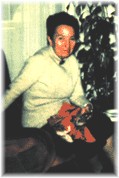
Control of the National Museum and Arts Administration was ceded by the French to the Cambodians on 9 August, 1951 and following Independence in 1953, the then Musée National de Phnom-Penh was the subject of Bilateral accords (7 November 1956). From 1956 to 1966, the museum continued to flourish under the direction of Madeleine Giteau, Conservatrice du Musée National.
1966 marked the appointment of Chea Thay Seng, the first Cambodian Director of the National Museum and Dean of the newly created Department of Archaeology at the Royal University of Fine Arts. This university that from its foundation as the Ecole des Arts cambodgiens in 1920 was intimately linked with students, artisans and teachers who worked to preserve Cambodian cultural traditions, can still be found to the rear of the museum.
The National Museum Today: Tourism and Culture
By the 1960s, the National Museum had become the centrepiece of a number of provincial museum collections scattered throughout Cambodia. Today, it is regaining that status – after years of neglect, closure and uncertainty, provincial museums are re-opening across the country.
Following the highly successful ASEAN Summit, this year has been designated ‘Visit Cambodia Year 2003’. As an integral part of appreciation of Khmer culture, visitors to Siem Reap should ensure their journey encompasses Phnom Penh for it is here the museum treasures of Cambodia are displayed. This world-class collection of Khmer art spans the gamut of history – from prehistory finds, through pre-Angkorian masterpieces to the art of the classic Angkor periods, and the post-Angkorian Middle Period. As Khun Samen, the current Museum Director has perceptively stated, “In order to better understand the evolution of Khmer art, it is preferable to study statuary and architecture together.”
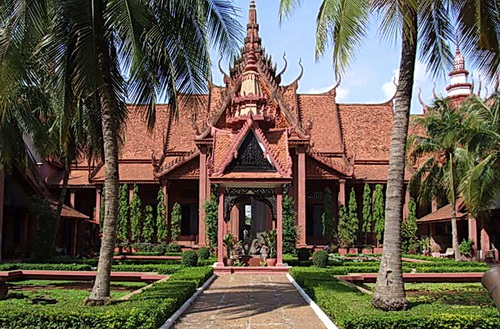
Entrance to the collection is gained by purchasing a ticket at the north gate and guide services in foreign languages are available. Visitors can also purchase souvenirs and publications (including ‘The New Guide to the National Museum’) from the bookshop just inside the main door.
How should the importance of this collection be defined? Khun Samen dedicates this guidebook, “to young Cambodians, … that they may come to appreciate and preserve their cultural heritage”; and to all Cambodian and international visitors, “may the five blessings of the Buddha be upon them.”
National Museum of Cambodia Timeline
Inaugurated: 13 April 1920, Khmer New Year
Renovated: by architect, Vann Molyvann late 1960s (central section, main building)
Closed: 12 April 1975 to 7 January 1979 (civil war)
Re-opened: 13 April 1979, Khmer New Year
Renovated: 1994-1995, roof and sections of building renovated with Australian government funding through AIDAB (now AusAID) and OPG. Ceremony to mark completion of work attended by HRH King Norodom Sihanouk and The Hon. Bill Hayden, AC, Governor-General of Australia, 28 April 1995.
Visitor Tips for the National Museum of Cambodia
Filination added this excellent article about visiting the National Museum of Cambodia in November 2010. It features recent photos inside and outside the museum and helpful tips for visitors. Also see this article about the National Museum of Cambodia’s 90th anniversary on devata.org.
About the author:
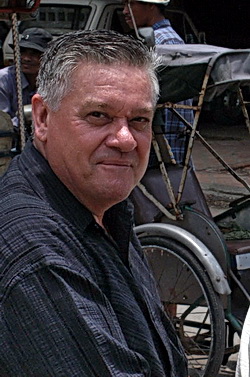
Darryl Collins first came to Cambodia in early 1994, to work with staff at the National Museum of Cambodia as one of a group of specialised museum staff and architects, who came to assist with a project funded by the Australian Government between 1993 and 1995. Darryl has remained in Cambodia ever since, lecturing at the Royal University of Fine Arts (Department of Archaeology) and as a co-member of a team of three in ARK Research (researching and publishing Building Cambodia: ‘New Khmer Architecture’: 1953-1970).
For five years he lectured at the Department of Archaeology, Royal University of Fine Arts, Phnom Penh. In mid-2004 he completed a 1-year consultancy with the Department of Culture and Research, the APSARA Authority, Siem Reap and he spends his spare time writing and researching art, architectural and cultural topics.
In late 2004, Darryl returned once more to part-time work at the National Museum, Phnom Penh as manager for the Collection Inventory Project that will, over a period of some 5 years register works of art and transfer early French records of the museum onto a purpose-designed database.
In 2010, Darryl accepted a position on the Board of Directors of Heritage Watch International, an international organization based in Cambodia that is devoted to protecting and preserving Cambodian heritage and antiquities.
Darryl resides in Siem Reap in an antique home he restored while studying traditional Cambodian houses. To visit Darryl’s home and read more about his work please visit http://www.darryl-siemreap.com/
